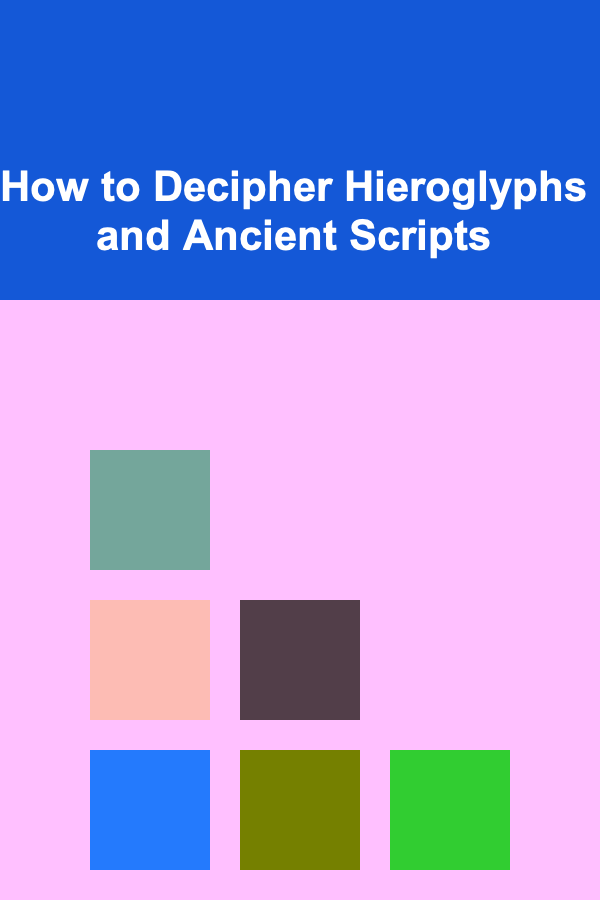
How to Decipher Hieroglyphs and Ancient Scripts
ebook include PDF & Audio bundle (Micro Guide)
$12.99$8.99
Limited Time Offer! Order within the next:

Deciphering ancient scripts, such as Egyptian hieroglyphs, is an intellectual journey that bridges the gap between the modern world and ancient civilizations. For centuries, these complex forms of communication remained a mystery, but the fascination with them has led to significant advancements in understanding ancient cultures, languages, and histories. This article will explore the process of deciphering hieroglyphs and ancient scripts, highlighting the challenges, breakthroughs, and the role of linguistics, archaeology, and modern technology in this field of study.
Understanding Hieroglyphs and Ancient Scripts
What are Hieroglyphs?
Hieroglyphs are a form of writing that uses pictures and symbols to represent words, sounds, or ideas. The term "hieroglyph" comes from the Greek words "hieros" (sacred) and "glyphein" (to carve), which reflects the script's use in sacred religious contexts, particularly in ancient Egypt.
Ancient Egyptian hieroglyphs are just one example of a broader phenomenon of ancient writing systems that included cuneiform in Mesopotamia, Mayan scripts in Central America, and the Indus script in South Asia. These scripts were used for different purposes, from administrative records and royal decrees to religious texts and monuments.
The Challenge of Deciphering Ancient Scripts
The primary challenge in deciphering ancient scripts lies in the fact that many of these scripts were abandoned or ceased to be used after the fall of their respective civilizations. With no direct descendants to pass down knowledge of how to read them, these ancient writings often lay dormant for centuries, if not millennia.
Furthermore, many of these scripts did not function in the same way as modern alphabets. While some, like the Phoenician alphabet, used characters to represent individual sounds (phonemes), others, like hieroglyphs, represented both sounds and meanings. This dual nature of the symbols added to the complexity of deciphering them.
Key Concepts in Deciphering Ancient Scripts
To decode an ancient script, scholars need to understand several key concepts:
1. The Structure of the Script
Understanding the structure of the script is the first step in deciphering it. This involves knowing whether the script is logographic, where each symbol represents a word or concept, or phonetic, where symbols represent sounds. Many ancient scripts are mixed, combining both logographic and phonetic elements. For instance, Egyptian hieroglyphs consist of pictorial symbols representing ideas or objects (logograms), as well as sounds (phonograms), and sometimes determinatives that clarify meaning.
2. Context and Translation
Context plays a crucial role in deciphering ancient scripts. In many cases, the symbols found on monuments, tombs, or scrolls are part of a larger narrative or historical context. Translating ancient texts requires an understanding of both the symbols and the context in which they were used. Scholars often begin by comparing known symbols or texts with similar scripts or languages to find patterns that might help in translation.
3. The Importance of Bilingual Texts
Bilingual or multilingual texts are invaluable resources for deciphering ancient scripts. These texts provide a direct comparison between an unknown language and a known language, allowing scholars to make educated guesses about the meanings of symbols. The most famous example of this is the Rosetta Stone, which provided the key to deciphering Egyptian hieroglyphs by comparing Greek text with hieroglyphs and demotic script.
4. Phonetic Value of Symbols
In some ancient scripts, symbols represent sounds rather than meanings. This requires identifying the phonetic value of the symbols, which can sometimes be difficult due to the lack of vowels or because a single symbol may have multiple meanings or phonetic values. For example, in Egyptian hieroglyphs, a single symbol might represent a sound, an idea, or even a whole word, depending on the context.
5. Cultural and Linguistic Knowledge
Understanding the cultural and linguistic context of the civilization that created the script is essential. Many ancient scripts are deeply intertwined with the religion, politics, and daily life of the people who used them. In the case of Egyptian hieroglyphs, for example, understanding ancient Egyptian culture, religion, and social structures was crucial to interpreting the meaning of many symbols.
Milestones in Deciphering Ancient Scripts
The Rosetta Stone and the Deciphering of Hieroglyphs
One of the most significant breakthroughs in the decipherment of ancient scripts came with the discovery of the Rosetta Stone in 1799 by French soldiers in Egypt. The stone, which dates back to 196 BCE, is a decree issued by King Ptolemy V in three scripts: Greek, Egyptian hieroglyphic, and Egyptian demotic.
Since Greek was well understood, scholars could use the Greek text to help them decipher the Egyptian scripts. The work of Jean-François Champollion, a French linguist, was instrumental in unlocking the mystery of hieroglyphs. By carefully comparing the Greek text with the hieroglyphs, Champollion was able to establish that some of the hieroglyphic symbols represented sounds, not just meanings. His work in the 1820s is regarded as the starting point of modern Egyptology.
Cuneiform and the Role of Archaeology
Cuneiform, the writing system of ancient Mesopotamia, was another major challenge for scholars. The script, which began around 3500 BCE, used wedge-shaped marks pressed into clay tablets. The script evolved over time, and by the 19th century, it had been mostly forgotten.
In the 19th century, scholars began to decipher cuneiform using the Behistun Inscription, a trilingual text carved into a cliff in modern-day Iran. This inscription, created by the Persian king Darius the Great, was written in three languages: Old Persian, Elamite, and Akkadian. Using Old Persian as a known language, scholars were able to decode the Akkadian cuneiform script, unlocking the ancient civilization's records and stories.
The Decipherment of Maya Glyphs
The Maya civilization, which flourished in Mesoamerica from around 2000 BCE to 1500 CE, used a complex script that combined logograms and syllabic symbols. Maya writing appeared on stelae, codices, and monuments, but for centuries, it was completely unreadable.
In the 20th century, scholars like Tatiana Proskouriakoff and David Stuart made significant progress in deciphering the Maya script. Proskouriakoff's work focused on recognizing the historical and calendrical information encoded in the inscriptions, while Stuart focused on deciphering the phonetic elements of the script. The discovery that many Maya symbols represented syllables rather than entire words was crucial in understanding their writing system.
The Indus Script: An Ongoing Mystery
Unlike the Rosetta Stone or the Behistun Inscription, no bilingual texts exist for the Indus script, used by the Harappan civilization in the Indus Valley (circa 3300--1300 BCE). Despite numerous attempts by linguists and archaeologists, the script remains largely undeciphered. The script appears on seals, pottery, and other artifacts, but the lack of a bilingual text makes decipherment exceptionally difficult. Some believe the script represents a Dravidian language, while others argue it may be unrelated to any known language family.
Modern Techniques in Deciphering Ancient Scripts
Digital Tools and Computational Linguistics
Advances in digital technology and computational linguistics have revolutionized the field of deciphering ancient scripts. Software tools that analyze patterns in writing have made it possible to process large amounts of data quickly and efficiently. This approach allows scholars to test hypotheses about the meanings of symbols by comparing them against other ancient texts, modern databases, and linguistic models.
Machine Learning and Artificial Intelligence
Machine learning, a subset of artificial intelligence (AI), is increasingly being used to decode ancient scripts. By training AI algorithms on large datasets of known texts, researchers can identify patterns that may not be immediately apparent to human scholars. This technology has already shown promise in the field of epigraphy (the study of inscriptions), and in the future, it may play a central role in deciphering scripts that have long eluded scholars.
Satellite Imaging and 3D Scanning
In addition to linguistic and computational tools, modern archaeology has benefitted from innovations in imaging technology. Satellite imaging and 3D scanning are helping researchers uncover ancient inscriptions that may have been obscured by time and environmental factors. For instance, 3D scanning can reveal hidden details on ancient tablets and monuments, while satellite images allow archaeologists to spot new inscriptions in remote locations.
Conclusion: The Ongoing Journey of Decipherment
The process of deciphering ancient scripts is a long and intricate journey, one that continues to evolve with advancements in linguistics, archaeology, and technology. Each breakthrough, whether it's the decipherment of Egyptian hieroglyphs or the analysis of Maya glyphs, brings us closer to understanding the cultures and histories of the civilizations that used them.
As we continue to develop new tools and techniques, the mysteries of ancient scripts that have long been hidden will gradually be unlocked. While some scripts, like the Indus script, may remain a mystery for the time being, the ongoing pursuit of knowledge and understanding ensures that the study of ancient writing will continue to captivate and enrich our understanding of human history.

How to Get Your Transportation Business Legally Registered: An Actionable Guide
Read More
How to Make the Most of Your Savings Account
Read More
How to Understand and Use Bonds in Your Investment Strategy
Read More
How to Understand the Business Applications of AR
Read More
How to Master Grooming Short-Haired Cats
Read More
How to Cultivate Empathy and Understanding
Read MoreOther Products

How to Get Your Transportation Business Legally Registered: An Actionable Guide
Read More
How to Make the Most of Your Savings Account
Read More
How to Understand and Use Bonds in Your Investment Strategy
Read More
How to Understand the Business Applications of AR
Read More
How to Master Grooming Short-Haired Cats
Read More